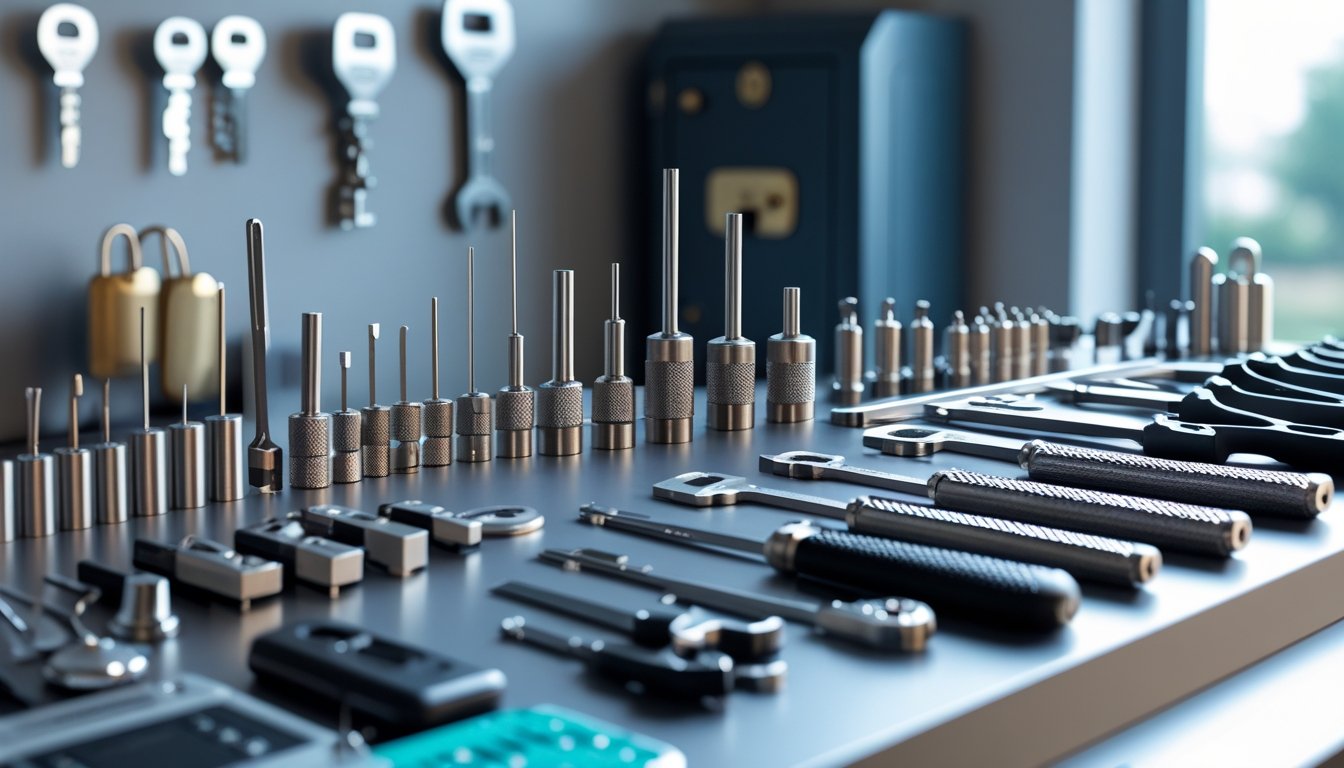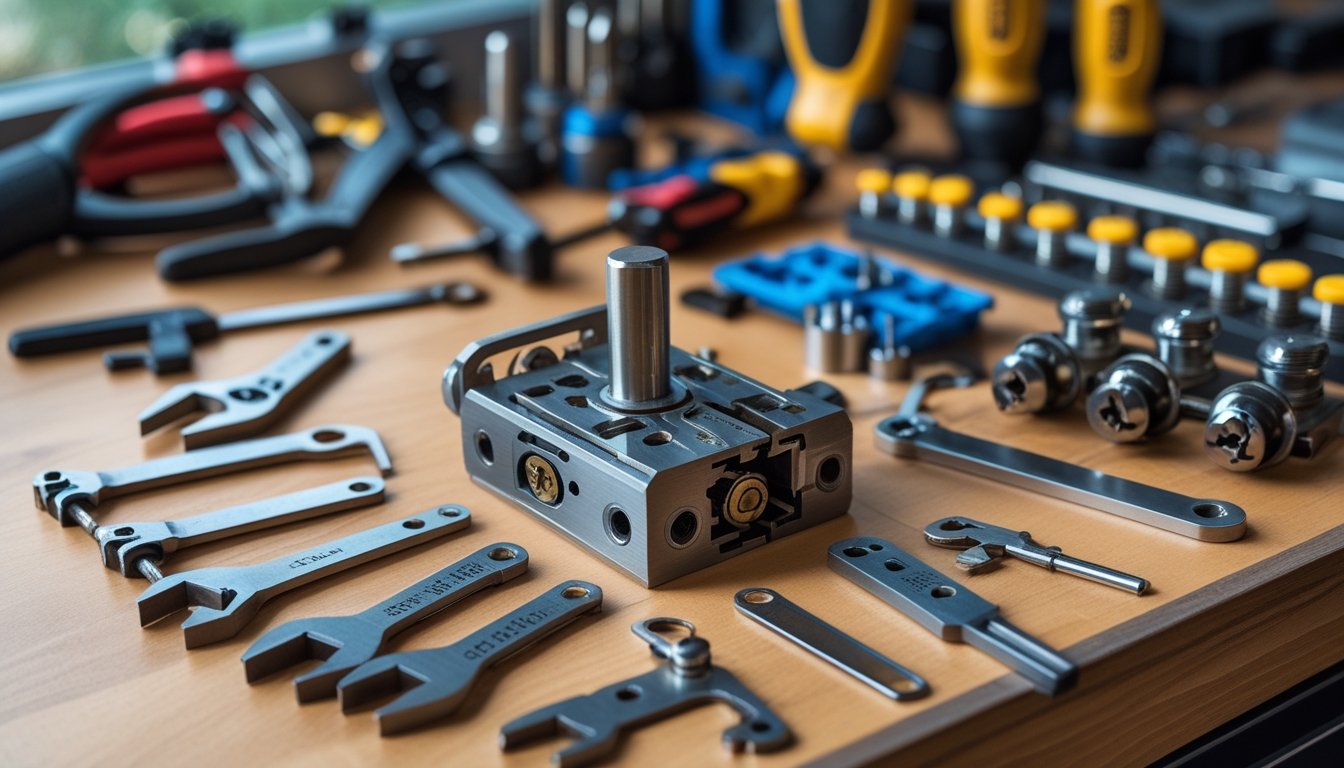Late updated: 14 Jul 2025 18:07
Written by: Elena Prescott
Understanding Locksmith Tools and Their Functions: A Comprehensive Guide
Locksmithing is an intricate trade steeped in history and often shrouded in mystery. Yet, at its core, it is about using the right tools for the job. Understanding the functions of locksmith tools is crucial for ensuring high-quality and reliable service. Our exploration of the toolbox unveils a blend of traditional craftsmanship and modern technology designed to tackle various security challenges.

Our journey through these tools begins with the essentials. Basic lock pick sets, key cutters, and tension wrenches form the foundation of any locksmith's arsenal. But today's locksmiths also rely on more advanced tools like electric lock pick guns and key decoders. These innovations highlight the evolving landscape of security services, where old and new methods converge to offer robust protection solutions.
As we delve further into this fascinating subject, we will address common questions about locksmith tools and their functions. Our goal is to equip you with practical insights into this profession, paving the way for a deeper appreciation of the expertise involved.
Key Takeaways
- Basic locksmith tools are essential for many security tasks.
- Advanced tools reflect the fusion of traditional and modern techniques.
- Understanding tool functions enhances service quality.
Essential Locksmith Tools and Their Functions
In the locksmith profession, certain tools are fundamental to performing various tasks efficiently. These include instruments for picking locks, applying torque, extracting keys, and manipulating lock components.
Lock Picks and Types
Lock picks are a cornerstone of any locksmith's toolkit. These slender devices are designed to interact with the intricate mechanisms inside locks. Hook picks are commonly used for finesse work, engaging individual pins within a lock. Rake picks, on the other hand, cover multiple pins at once, making them ideal for quicker picks in simpler locks.
For beginners, a basic lock pick set typically contains a variety of hook and rake picks, providing a balance of precision and speed. Advanced locksmiths might also utilise tubular lock picks for locks of tubular design, which require unique handling techniques.
Tension Wrenches and Torque Wrenches Explained
Tension wrenches, often overlooked, are essential for applying the right amount of torque. These tools hold the lock’s cylinder in place while picks manipulate the internal pins. A subtle art, mastering the application of tension is critical to successfully picking a lock without damage.
Torque wrenches serve a similar function but are typically used for tasks requiring calibrated torque applications, especially in mechanical locks with more precise torque needs. Their importance lies in providing consistent pressure, which prevents stripping or breaking the lock.
Key Extractors and Removal Techniques
Key extractors are vital when dealing with broken keys lodged within locks. These slender, hook-like tools are designed to safely remove fragments without further damaging the lock mechanism.
They come in various shapes and sizes, optimised for different key types and lock designs. For efficient removal, it's often necessary to employ techniques such as gentle rocking and careful gripping, utilising fine-tipped tweezers or specific key extractors for precision.
Plug Spinners for Lock Manipulation
Plug spinners are intriguing tools used to correctly reorient a lock’s plug after successful picking. When a lock is picked in the incorrect direction, the plug spinner swiftly rotates it back to its intended position. This tool is paramount for locks requiring precise directional alignment post-picking.
Quick and precise, a plug spinner helps prevent the lock from relocking during this process. It's especially useful in environments where rapid lock adjustments are necessary under time constraints, emphasising the need for dexterity and speed in professional locksmith tasks.
Advanced Tools for Locksmithing and Security Services

In the realm of locksmithing and security services, the adoption of advanced tools has elevated both efficiency and precision. Our discussion focuses on four pivotal tools: key cutting machines, lock pick guns, key decoders, and sophisticated access control systems. These tools empower locksmiths to provide robust solutions to evolving security needs.
Key Cutting Machines and Key Cutting
Key cutting machines play a crucial role in replicating and crafting keys with precision. We use these machines to achieve exact duplicates necessary for high-security locks. Their efficiency results from automated systems that minimise human error and allow for consistent and repeatable results.
Key cutting involves both duplicating existing keys and cutting new ones from codes or lock mechanisms. The process is indispensable not only for residential and commercial purposes but also for automotive locksmithing. Advances in technology have spawned machines capable of handling a wide array of key styles, enhancing the range of locksmith services.
Lock Pick Guns and Bump Keys
Our toolkit of lock pick guns and bump keys provides non-destructive entry methods to open locks without existing keys. Lock pick guns, including electric and manual types, simulate the act of manual lock picking but achieve results faster. Just as important are bump keys, which exploit the physics of conventional lock mechanisms to turn a locked tumbler into an open one.
The application of these tools requires sophisticated knowledge and meticulous skill. They facilitate access in situations ranging from accidental lockouts to complex entry situations. Our proficiency in these tools ensures minimal damage and time-efficient results.
Key Decoders and Their Uses
Key decoders are the unsung heroes of locksmithing, translating key data into actionable information. These devices allow us to read the bitting of a key or the key code, often without needing the original. Key decoders are vital for duplication processes and creating master keys from scratch when codes are unavailable.
Their precision in decoding complex key patterns supports locksmith services by preserving the integrity of high-security locks. This ability extends our proficiency in maintaining, adjusting, and servicing locks without unnecessary replacements.
Electronic Access Control and Master Key Systems
In today’s security landscape, electronic access control systems are paramount. These systems offer programmable control over who enters specific areas and when. We witness their integration in businesses, instituting heightened security protocols tailored to specific needs. Our expertise extends to setting up and maintaining these systems to maximise their efficacy.
Master key systems, on the other hand, consolidate locks under a unified key framework. This system provides individual access while maintaining overarching control. Our implementation of master key systems ensures operational flexibility and security, balancing accessibility with hierarchical access.
Frequently Asked Questions

In this section, we provide insights into some critical questions about locksmith tools. These FAQs aim to highlight the essential equipment, costs, innovations, and safety considerations associated with locksmithing.
What essential tools are included in a locksmith's toolkit?
A locksmith's toolkit typically comprises various items. Basic lock picks, tension wrenches, and key decoders are foundational. Advanced sets might include electric pick guns and impressioning kits. Each tool serves a specific function, essential for addressing different locking mechanisms.
What is the average investment required to procure professional locksmith equipment?
The initial investment for a professional locksmith's equipment varies. Typically, one can expect to spend between £500 to £2,000. This range accounts for basic to more sophisticated tools required for offering comprehensive locksmith services.
How does a locksmith utilise a pick gun?
A pick gun operates by rapidly striking the pins inside a lock. This action causes the pins to momentarily jump, allowing the locksmith to turn the lock open. Mastery of its use requires practice to prevent damage to lock mechanisms.
What are the safety implications of using locksmith tools?
Using locksmith tools requires caution. Inadequate handling can lead to property damage or legal consequences if used improperly. Adequate training ensures security and compliance with regulations governing the use of such equipment.
What innovations have recently emerged in locksmith technology?
Recent innovations include advancements in digital lock technology and smart security systems. Tools now incorporate electronic features, enabling locksmiths to address both traditional locks and modern, tech-driven security requirements.
How does a tension wrench function in lock picking?
A tension wrench applies rotational force to a lock, holding the pins in place. It works in tandem with picks to manoeuvre the pins within the lock cylinder. Proper use is crucial for successfully picking a lock without causing harm.
